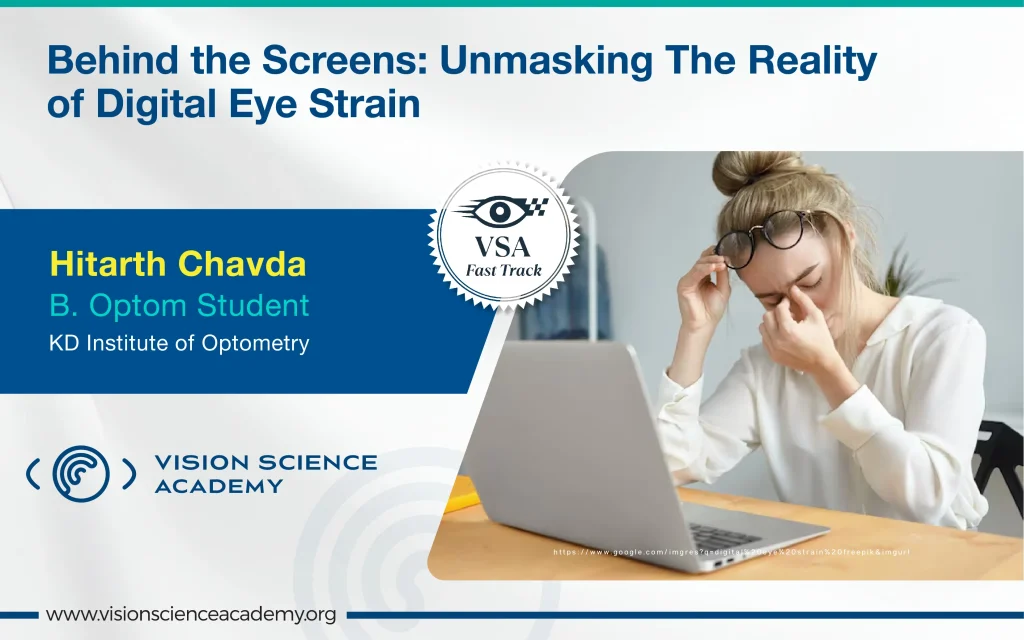Hitarth Chavda, B.Optom. Student,
KD Institute of Optometry, Ahmedabad, India
Digital Eye Strain (DES), also known as Computer Vision Syndrome (CVS), is no longer limited to office workers or gamers, it’s now a universal concern. From smartphones to laptops, the surge in screen time has introduced a wide range of visual and non-visual symptoms, including eye fatigue, dryness, burning, blurred vision, and even neck and shoulder pain. These symptoms fall into two broad categories: internal (linked to accommodative and binocular stress) and external (often due to dry eye and decreased blink rate). (1,2)
A Wake-Up Call for Students and Screen Users
Research on medical students found that more than two-thirds had DES symptoms. The most common complaints included burning, dryness, and headache. Notably, the likelihood of reporting more severe symptoms was higher among women, smartphone users, and people who did not use lubricating eye drops. It is concerning to note that almost 11% of the individuals had severe DES, which raises serious concerns regarding their academic performance and quality of life. (1)
Why Does It Matters Now More Than Ever?
Post-pandemic life has shifted work, education, and entertainment to virtual platforms. This shift has particularly impacted children and young adults, with students now spending more time than ever on digital screens, leading to increased DES prevalence. (3,4) Even young children are affected, often experiencing symptoms previously only reported by adults. With estimates suggesting that 64–90% of computer users face DES, it’s a true public health concern.
Despite being common, DES is often underdiagnosed. Diagnostic tools like the Computer Vision Syndrome Questionnaire (CVS-Q) are widely used, while some researchers have investigated objective measures like blink rate, pupil response, and accommodation, although the correlation with symptoms is not always clear.
Management Strategies: Prevention is the Best Cure
As the multifactorial origin of DES, its treatment necessitates a global, lifestyle-based approach that integrates environmental changes, ocular remedies, and behavioural adjustments. (2,5,6)
- The 20-20-20 Rule
a. Instruct patients to adopt this easy yet efficient method: Take a 20-second break every 20 minutes and gaze at something 20 feet away. - Ergonomic Adjustments
- a. Provide adequate screen height (at eye level or slightly below)
- b. Keep a comfortable viewing distance (20–28 inches)
- c. Use anti-glare screens and proper illumination to minimize strain
- Refractive Correction
- a. Correct uncorrected refractive errors, especially hyperopia
- b. Prescribe anti-fatigue or accommodative support lenses as indicated
- Artificial Tears and Hydration
- a. Recurrent use of lubricating eye drops can relieve dryness
- b. Encourage adequate hydration and environmental humidification
- Blue-Light Filtering Lenses
- a. Though in dispute, some patients experience symptomatic relief.
- b. Present evidence regarding their effectiveness remains inconclusive.
- Digital Literacy
a. Educating consumers, specifically children, parents, and educators — on screen hygiene, body positioning, and breaks is important to prevention in the long term.
Conclusion: A Call to Action for Eye Care Professionals
Digital Eye Strain is no longer a nascent issue, it is a widespread clinical phenomenon demanding our immediate attention. Eye care practitioners must actively screen for DES symptoms in routine exams, especially in students, young adults, and extensive screen users. With evidence-based recommendations, early diagnosis, and patient information, we can minimise the effects of DES and promote visual comfort in today’s screen-drenched society. By incorporating digital eye health into mainstream discussion and clinical practice, we move an important step toward protecting ocular health for future generations. (3,4)
References:
- Aghaei, H., & Abdolalizadeh, P. (n.d.). Computer Vision Syndrome.www.intechopen.com
- Pavel, I. A., Bogdanici, C. M., Donica, V. C., Anton, N., Savu, B., Chiriac, C. P., Pavel, C. D., & Salavastru, S. C. (2023). Computer Vision Syndrome: An Ophthalmic Pathology of the Modern Era. Medicina (Lithuania) (Vol. 59, Issue MDPI. https://doi.org/10.3390/medicina5902041
- Alqarni, A. M., Alabdulkader, A. M., Alghamdi, A. N., Altayeb, J., Jabaan, R., Assaf, L., & Alanazi, R. A. (2023). Prevalence of Digital Eye Strain Among University Students and Its Association with Virtual Learning During the COVID-19 Pandemic. Clinical Ophthalmology, 17, 1755–1768. https://doi.org/10.2147/OPTH.S406032
- Sheppard, A. L., & Wolffsohn, J. S. (2018). Digital eye strain: Prevalence, measurement and amelioration. In BMJ Open Ophthalmology (Vol. 3, Issue 1). BMJ Publishing Group.https://doi.org/10.1136/bmjophth-2018-000146\
- Mylona, I., Glynatsis, M. N., Floros, G. D., & Kandarakis, S. (2023). Spotlight on Digital Eye Strain. Clinical Optometry (Vol. 15, pp. 29–36). Dove Medical Press Ltd.https://doi.org/10.2147/OPTO.S389114
- Kaštelan, S., Tomić, M., Salopek-Rabatić, J., & Novak, B. (2013). Diagnostic procedures and management of dry eye. BioMed Research International (Vol. 2013). https://doi.org/10.1155/2013/309723
